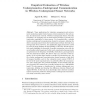Free Online Productivity Tools
i2Speak
i2Symbol
i2OCR
iTex2Img
iWeb2Print
iWeb2Shot
i2Type
iPdf2Split
iPdf2Merge
i2Bopomofo
i2Arabic
i2Style
i2Image
i2PDF
iLatex2Rtf
Sci2ools
105
click to vote
DCOSS
2009
Springer
2009
Springer
Empirical Evaluation of Wireless Underground-to-Underground Communication in Wireless Underground Sensor Networks
Abstract. Many applications for irrigation management and environment monitoring exploit buried sensors wired-connected to the soil surface for information retrieval. Wireless Underground Sensor Networks (WUSNs) is an emerging area of research that promises to provide communication capabilities to these sensors. To accomplish this, a reliable wireless underground communication channel is necessary, allowing the direct communication between the buried sensors without the help of an aboveground device. However, the significantly high attenuation caused by soil is the main challenge for the feasibility of WUSNs. Recent theoretical results highlight the potential of smaller attenuation rates with the use of smaller radio frequencies. In this work, experimental measurements are presented at the frequency of 433MHz, which show a good agreement with the theoretical studies. We observe that (a) a decrease of the frequency of the wireless signal implies a smaller soil attenuation rate, (b) the ...
DCOSS 2009 | Distributed And Parallel Computing | Sensor | Underground Communication Channel | Wireless Underground Communication |
Related Content
| Added | 17 Feb 2011 |
| Updated | 17 Feb 2011 |
| Type | Journal |
| Year | 2009 |
| Where | DCOSS |
| Authors | Agnelo R. Silva, Mehmet C. Vuran |
Comments (0)

